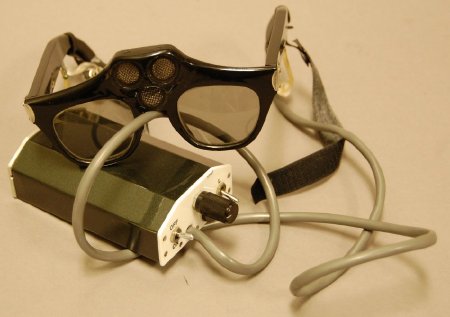Object ID:
2013.20.5
Title:
Binaural Sensor
Creator:
Kay, Leslie
Description:
(a) Heavy black plastic eyeglass frames, three screen covered circles above bridge, lower circle houses transmitter and upper two house receivers; miniaturized clear plastic hearing aids in earpieces; gray insulated cable from left temple leads to pentagonal steel control box, box enameled in dark gray metal-flek with bright finished aluminum and white plastic ends, aluminum end houses battery compartment, white end has on/off toggle, rotary volume control, and low/high toggle as well as remote jack, stamped "V147"; belt clip on bottom and adhesive label, "MANUFACTURED BY/VIGILANT LTD./CHRISTCHURCH, NEW ZEALAND/U.S. PATENT NOs 3366922/3172075"; (b) brown vinyl carrying case; hinged lid secured by spring latch with key lock; carry handle with nickel plated steel gardware; interior has brown polyester pillow forms which hold unit in place; below latch in black and yellow Dynatape, in print & braille, "PAUL FILPUS"; (c) battery charger: gray-green metal flek enamel, rectangular body with two trays for batteries; copper and Bakelite terminals; felt on base; fuse on one side; brown plastic power cord.
Dimensions:
H-10.5 W-8.5 D-4 inches
Date:
1970
Made by:
Vigilant LTD; Kay, Leslie
Place of Origin:
Christchurch, New Zealand
Provenance:
Donor lost sight in a car accident in 1970 at age 29. A former civil engineer, he retrained as a computer programmer and went to work for Miles Laboratories in Elkhart, IN. He received the Binaural Sensor from the Michigan Agency for the Blind during his rehabilitation. He used and evaluated it--it was in the early stages of development--at the Michigan Rehabilitation Center for the Blind in Kalamazoo. He found it "especially useful when making street crossings at major intersections."
During the 1950s, Dr. Leslie Kay developed sonar technology to detect submerged objects for the British Navy. Conceived in 1959 at the University of Birmingham, the Sonicguide was not fully functional until 1966. The first evaluations took place in Australia and New Zealand. By 1971, it was being widely tested in the U.S. Unlike the Russell Pathsounder, with its emphasis on go-no go information, the Sonicguide communicated an abundance of information, providing distance estimation, directional information, and tonal information that promised to provide object identification after considerable practice. Intended as a secondary ETA used with a dog or long cane, it was the subject of several courses for trainers throughout the 1970s and early 1980s.
During the 1950s, Dr. Leslie Kay developed sonar technology to detect submerged objects for the British Navy. Conceived in 1959 at the University of Birmingham, the Sonicguide was not fully functional until 1966. The first evaluations took place in Australia and New Zealand. By 1971, it was being widely tested in the U.S. Unlike the Russell Pathsounder, with its emphasis on go-no go information, the Sonicguide communicated an abundance of information, providing distance estimation, directional information, and tonal information that promised to provide object identification after considerable practice. Intended as a secondary ETA used with a dog or long cane, it was the subject of several courses for trainers throughout the 1970s and early 1980s.
Credit Line:
Gift of Paul Filpus, 2013.20
